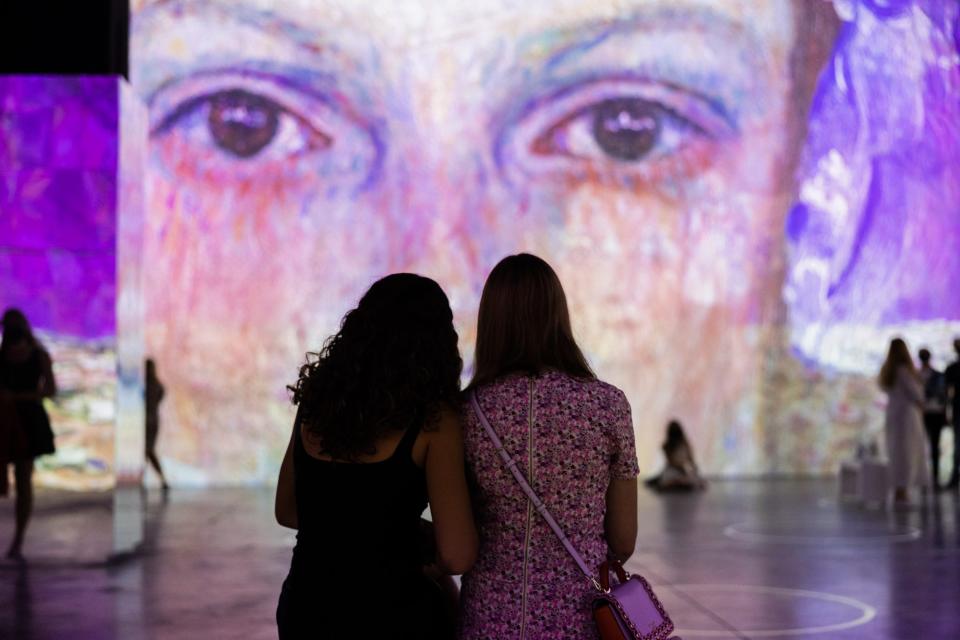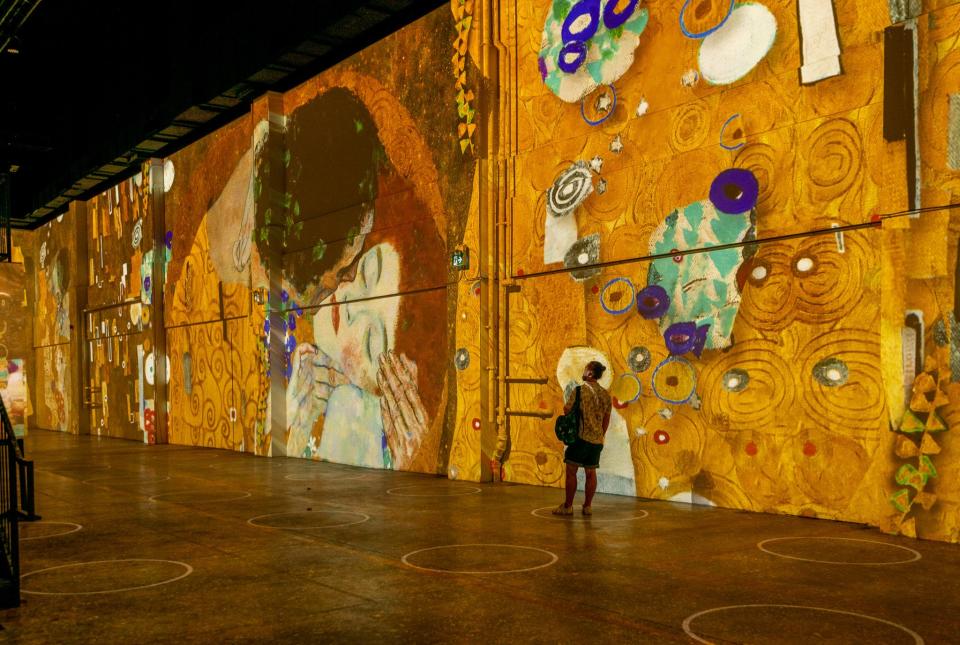Video installation immerses audience in Gustav Klimt’s 'mind-blowing' vision

"Immersive Klimt: Revolution," which debuted April 14 at Lighthouse ArtSpace inside The Castle on Columbus Avenue in Boston, is the next mesmerizing video installation from Lighthouse Immersive.
Toronto-based Lighthouse Immersive is on a roll after immersive Van Gogh and Frida Kahlo installations, the non-immersive The Art of Banksy, and most recently Immersive Shevchenko: Soul of Ukraine, a day-long fundraiser with all proceeds from tickets sales going to humanitarian aid in Ukraine. (Note, the two recent immersive Van Gogh exhibits in Boston were not produced by Lighthouse, whose exhibit toured to other parts of the country.)
This time, Gustav Klimt’s psychedelic, abstract, Art Nouveau paintings and some of his sketches are dissected and reimagined in an exhibit that debuted in Toronto before opening in Arizona and now Boston.
Van Gogh, Kahlo, and Klimt share a common trait: the three artists were iconoclasts, breaking new ground in art and turning away from traditions that served neither them and, as it turned out, the evolution of art.
Immersive Frida Kahlo creator Massimiliano Siccardi worked from thousands of Klimt’s sketches and paintings, including Klimt’s groundbreaking abstract-psychedelic “The Kiss” and “Tree of Life” — the latter inspired Massachusetts College of Art and Design's so-called Tree House residence hall in the Fenway.
“What he does is very poetic,” said creative consultant Richard Ouzounian, who researches and writes the catalog for the exhibits. Siccardi created 13 sequences, or 13 chapters, which Ouzounian set about framing in a biography: “It’s like art history, but not as dry,” he explained.
Compelling research
And researching Klimt’s story has been far from dry.
“I thought I knew his work,” Ouzounian said. “But the more you study and look at every painting, a lot more comes out. Klimt is much more important than I knew.”

Gustav Klimt, who was born in 1862 in Baumgarten near Vienna during the final years of the Austrian Empire, co-founded the Vienna Secession, an artistic movement that shifted from the classical painting styles, hence the title: Immersive Klimt: Revolution.
Klimt’s post impressionist mixture of abstract impressionism, Art Nouveau and psychedelia — before any of those styles had a name — resulted in portraiture of astounding lifelikeness and landscapes of breathtaking beauty. He blurred lines between mundane physical boundaries of human perception and the ecstatic ethereal world of essential nature. As Ouzounian put it, “His work was mind-blowing.”
The installation combines art exhibit with biography as Siccardi intersperses Klimt’s work with that of contemporaries, Egon Schiele, a Klimt protégée, and fellow Vienna Secessionist Kolomon Moser. All three artists died in 1918, Moser from cancer and Klimt and Schiele as a result of the Spanish flu pandemic.
“When Schiele’s work comes in you feel there is something different. A different artistic energy has entered the room,” Ouzounian explained.
“We also want to give a feel for what it was like to be in Vienna when all of a sudden you go from Strauss to Schoenberg, and Siegmund Freud was putting people on his couch,” Ouzounian added. “Everything was changing. There was a cultural revolution; it was a fascinating period.”
Techno-pop vibe
Music is a valuable component in presenting the story, and Italian composer and pianist Luca Longobardi’s soundtrack plays out to a dramatic, unexpected finale.
“For the final sequence, in the final eight minutes the music switches from Schoenberg to David Bowie’s 'Heroes' sung in German, and then it ends in 21st-century techno pop.”
A progression perfect for Klimt, who in modern parlance was a disruptor, his magnificent work steeped in magical symbolism as much as it was provocative sensuality, even eroticism.
One of Klimt’s “philosophical aphorisms,” said Ouzounian, was “all art is erotic.” But unlike most classic nude studies, Klimt painted women owning their physical form, owning their bodies and their lives. “There is certainly a sensuality to Klimt’s work, but his nudes don’t lie prone, they look straight at you. He respected women enormously,” he said.
Nowhere is that more apparent as when Klimt bathed them in gold leaf as he did with "Portrait of Adele Bloch-Bauer I," or "The Woman in Gold," which depicted the Austrian Jewish socialite rumored to be one of Klimt’s many lovers and reputedly the figure in Klimt’s Byzantine mosaic influenced "The Kiss."
May we speculate that the male figure is Klimt? Unlike Van Gogh and Kahlo, and even Schiele, Klimt never painted a self portrait: “He wanted people to look at his paintings and to see him in them,” said Ouzounian.
What we do see as Siccardi fragments the complex paintings, breaking them down and highlighting elements, is Klimt’s incredible imagination and vision.
“In his work you can see Picasso, Mondrian and Rothko,” said Ouzounian of Klimt’s influence on modern art. “It’s almost like Klimt could see what was coming.”
Immersive Klimt: Revolution runs through May 30 at Lighthouse ArtSpace, 130 Columbus Ave., Boston. Tickets from $39.99. Go to immersiveklimt.com for more info.
This article originally appeared on Telegram & Gazette: Gustav Klimt’s 'mind-blowing' work explored in immersive installation
